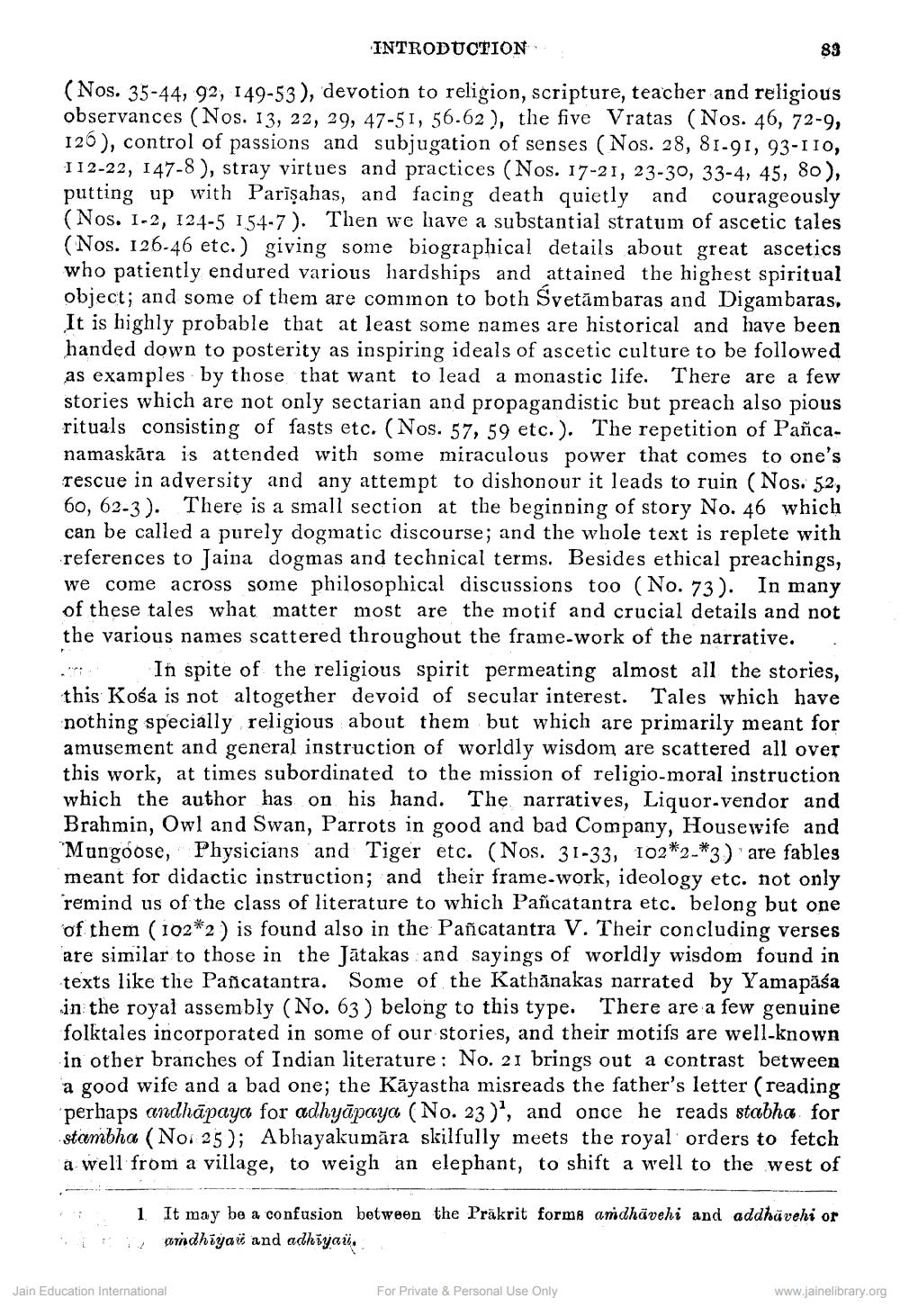________________
INTRODUCTION
83
(Nos. 35-44, 92, 149-53), devotion to religion, scripture, teacher and religious observances (Nos. 13, 22, 29, 47-51, 56.62 ), the five Vratas (Nos. 46, 72-9, 126), control of passions and subjugation of senses (Nos. 28, 81-91, 93-110, 112-22, 147-8), stray virtues and practices (Nos. 17-21, 23-30, 33-4, 45, 80), putting up with Parişahas, and facing death quietly and courageously (Nos. 1-2, 124-5 154-7). Then we have a substantial stratum of ascetic tales (Nos. 126-46 etc.) giving some biographical details about great ascetics who patiently endured various hardships and attained the highest spiritual object; and some of them are common to both Svetămbaras and Digambaras. It is highly probable that at least some names are historical and have beer handed down to posterity as inspiring ideals of ascetic culture to be followed as examples by those that want to lead a monastic life. There are a few stories which are not only sectarian and propagandistic but preach also pious rituals consisting of fasts etc. (Nos. 57, 59 etc.). The repetition of Pañca. namaskāra is attended with some miraculous power that comes to one's rescue in adversity and any attempt to dishonour it leads to ruin (Nos. 52, 60, 62-3). There is a small section at the beginning of story No. 46 which can be called a purely dogmatic discourse; and the whole text is replete with references to Taina dogmas and technical terms. Besides ethical preachings, we come across some philosophical discussions too (No. 73). In many of these tales what matter most are the motif and crucial details and not the various names scattered throughout the frame-work of the narrative. .
In spite of the religious spirit permeating almost all the stories, this Kośa is not altogether devoid of secular interest. Tales which have nothing specially religious about them but which are primarily meant for amusement and general instruction of worldly wisdom are scattered all over this work, at times subordinated to the mission of religio-moral instruction which the author has on his hand. The narratives, Liquor-vendor and Brahmin, Owl and Swan, Parrots in good and bad Company, Housewife and Mungoose, Physicians and Tiger etc. (Nos. 31-33, 102*2-*3) are fables meant for didactic instruction; and their frame-work, ideology etc. not only remind us of the class of literature to which Pancatantra etc. belong but one of them (102*2) is found also in the Pañcatantra V. Their concluding verses are similar to those in the Jātakas and sayings of worldly wisdom found in texts like the Pañcatantra. Some of the Kathānakas narrated by Yamapāśa in the royal assembly (No. 63) belong to this type. There are a few genuine folktales incorporated in some of our stories, and their motifs are well-known in other branches of Indian literature: No. 21 brings out a contrast between a good wife and a bad one; the Kāyastha misreads the father's letter reading perhaps andhāpaya for adhyāpaya (No. 23)', and once he reads stabha for stambha (No. 25); Abhayakumāra skilfully meets the royal orders to fetch a well from a village, to weigh an elephant, to shift a well to the west of
1 It may be a confusion between the Präkrit forms amdhāvehi and addhivehi or
o ndhiyai and adhiyai.
Tr
Jain Education International
For Private & Personal Use Only
www.jainelibrary.org




